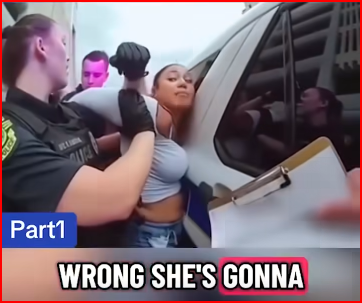Introduction: A Video That Captured Global Attention
In today’s digital landscape, where millions of videos compete for attention across social media platforms, few manage to spark the level of debate, concern, and reflection as one particular bodycam recording that surfaced this week. At first glance, the footage seemed like a routine interaction between law enforcement officers and a civilian. A woman leaning against a patrol vehicle appeared composed, almost detached, as officers held her by the arm. For casual observers, there was little to suggest that anything unusual was about to unfold.
Yet within moments, that calm exterior gave way to a sudden outburst that dramatically changed the energy of the scene. The brief clip, which ends abruptly without context or resolution, has since fueled millions of discussions online. From psychologists analyzing human behavior, to citizens questioning police procedure, to casual viewers simply expressing shock, the viral bodycam video has become more than just a snapshot of one encounter—it has turned into a case study of unpredictability in moments of stress.
The Scene Unfolds: Composure Before the Shift
The recording begins with officers standing beside the woman near a police cruiser. Their hands maintain a firm but seemingly standard grip on her arm. Her posture is neutral, her gaze steady, her body language giving little away. She does not shout, argue, or visibly resist. Instead, she appears almost withdrawn, lips pressed together, shoulders still.
Observers describe this stage as “eerily calm,” as though she were conserving her energy or processing the gravity of the situation internally. Some have compared it to the quiet before a storm—an unsettling pause where tension hangs invisibly in the air.
This sense of composure is what made the following transition so startling.
The Abrupt Escalation
Without warning, her demeanor fractures. The instant one officer tightens his grip, the woman suddenly reacts. A piercing scream breaks the silence, followed by rapid, chaotic movements. She twists her body, tugs against restraint, and lashes out in an attempt to break free.
The shift is dramatic, almost cinematic in its intensity. Viewers describe it as going from “zero to one hundred” in the blink of an eye. The calm exterior, which had seemed so controlled, vanishes in an instant, replaced by a raw, instinctive struggle.
What happens next remains unclear. The video cuts off at the peak of the confrontation, leaving unanswered questions about whether additional officers arrived, whether force was escalated further, or what legal consequences followed.
Why the Clip Resonates: The Social Media Impact
Within hours of being posted, the footage spread across TikTok, Instagram, X (formerly Twitter), and YouTube. Millions of views turned into tens of thousands of comments. Users shared their shock, sympathy, and speculation:
- “That switch was intense—you could almost feel it coming but still weren’t ready.”
- “She looked like she was waiting for the exact moment to react.”
- “Maybe it wasn’t strategy at all—just pure panic setting in.”
The reactions highlight how one short video can ignite widespread debate, not only about the individual involved but also about broader issues: how humans react under extreme stress, how law enforcement manages sudden escalation, and how much meaning can (or cannot) be extracted from a few seconds of footage.
The viral spread of this clip demonstrates once again the power of digital platforms to transform a local incident into a global conversation within hours.
Understanding Human Behavior: Why Calm Turns to Chaos
Psychologists and behavioral experts often point to several frameworks that can help explain sudden, dramatic shifts in demeanor:
1. The Fight-or-Flight Response
When individuals feel threatened or restrained, the body’s nervous system can suddenly shift into survival mode. Even someone appearing calm may experience rising stress internally, which then erupts when pressure crosses a certain threshold.
2. Tactical Composure
Another interpretation is that individuals may consciously adopt a calm appearance, either as a coping strategy or to mask their intentions. The outburst may not be accidental but rather a calculated attempt to resist at an unexpected moment.
3. Emotional Collapse
Sometimes, composure is only temporary. The realization of losing freedom, the sight of handcuffs, or the presence of authority can overwhelm mental balance. What appears like control can quickly unravel into panic or defiance.
4. Raw Instinct
Not every reaction is logical or planned. Some responses are purely instinctive—reflexive bursts of fear, anger, or desperation that bypass reason altogether.
In this case, the shift appeared so immediate that it may have involved a mixture of several factors.
The Unknown Aftermath
One of the reasons this clip continues to spark conversation is the mystery surrounding what happened after the recording stops. Questions remain unanswered:
- Were formal charges filed?
- Did officers escalate their use of force in response?
- Was medical support or additional backup called?
- Did official reports document the full sequence of events?
- Has the department released a statement clarifying the incident?
At the time of writing, no comprehensive public report has been released. The lack of closure fuels speculation, leaving audiences to fill in the blanks with assumptions or personal perspectives.
The Broader Significance: Why This Video Strikes a Chord
Beyond the immediate drama, this viral moment connects with larger cultural and societal themes:
1. The Challenges of Law Enforcement
Police officers regularly face unpredictable situations. What appears calm and manageable can change without warning. This unpredictability highlights both the risks officers face and the importance of de-escalation training.
2. The Power of Video Evidence
Bodycams and bystander recordings serve as vital accountability tools. Short clips can both illuminate and obscure events—revealing moments of tension but sometimes leaving critical context unseen.
3. Public Perception of Authority
Incidents like this influence how communities view law enforcement. Depending on interpretation, the video can either reinforce concerns about restraint tactics or highlight the difficulties officers face when people suddenly resist.
4. Human Psychology Under Stress
The calm-to-chaos transition is a vivid reminder that human behavior under duress cannot always be predicted. It complicates simple narratives of “cooperation” versus “resistance” and invites empathy for the unseen psychological pressures at play.
Why the Silence Around the Aftermath?
Observers often criticize the lack of official comment following viral incidents. Several factors may explain limited disclosure:
- Ongoing internal reviews: Departments often withhold details while investigations proceed.
- Legal concerns: Premature statements may expose liability.
- Media strategy: Controlling narratives helps agencies avoid fueling speculation.
- Operational confidentiality: Protecting protocols and personnel is sometimes prioritized over public disclosure.
Yet in today’s era of instant media, silence is frequently interpreted as avoidance. The balance between transparency and caution remains a pressing challenge.
Lessons & Questions for Reflection
This incident raises important points for law enforcement, policymakers, and communities:
- Training for Sudden Escalation
How well are officers equipped to recognize early signs of distress and adjust their approach? - Protocols for Physical Restraint
Could subtle changes in handling reduce the risk of triggering panic or aggression? - Transparency and Trust
How can agencies build confidence by providing timely, accurate information after such incidents? - The Role of Mental Health
How often do hidden trauma or personal crises shape reactions in high-stress encounters?Buy vitamins and supplements - The Power of Narrative
How much of our understanding comes from what is seen—and how much from what is assumed?
Real-World Consequences
While online debates are abstract, the real individuals involved face tangible outcomes:
- Legal proceedings: Potential charges for resisting or disorderly conduct.
- Officer accountability: Internal reviews of tactics and use-of-force decisions.
- Community impact: Shifts in trust, fear, or calls for reform.
- Mental health considerations: Assessments of stress, trauma, or fitness for trial.Buy vitamins and supplements
The ripple effects extend well beyond the minutes of recorded footage.
Conclusion: A Moment That Lingers
The viral bodycam clip is more than a flash of drama—it is a mirror reflecting the complexities of human behavior, authority, and perception in today’s society. It reminds us that appearances can mislead, that control can collapse in seconds, and that every encounter between citizens and law enforcement carries layers of unseen tension.
The unanswered questions surrounding the aftermath only deepen the resonance of the video. Viewers are left not with certainty, but with reflection: What really happened? What could have been done differently? And how should we interpret the fragile balance between composure and chaos?


